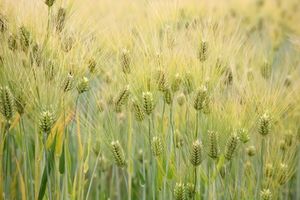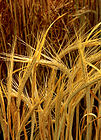Note: This is a project under development. The articles on this wiki are just being initiated and broadly incomplete. You can Help creating new pages.
Difference between revisions of "Hordeum vulgare - Aksata"
Chaithrika (talk | contribs) (+adding internal link) |
|||
| (29 intermediate revisions by 2 users not shown) | |||
| Line 1: | Line 1: | ||
[[File:Barley (Hordeum vulgare) - United States National Arboretum - 24 May 2009.jpg|thumb|right|''Barley'', ''Hordeum vulgare'']] | [[File:Barley (Hordeum vulgare) - United States National Arboretum - 24 May 2009.jpg|thumb|right|''Barley'', ''Hordeum vulgare'']] | ||
| + | '''Hordeum vulgare''' is a member of the grass family. It is a major cereal grain grown in temperate climates globally. It was one of the first cultivated grains, particularly in Eurasia as early as 13,000 years ago. Barley grains are commonly made into malt in a traditional and ancient method of preparation.Its germination time is one to three days. | ||
| + | ==Uses== | ||
| + | {{Uses|Styptic}}, {{Uses|wound healer}}, {{Uses|Musculoskeletal disorder}}, {{Uses|abcess}}, {{Uses|snake bite}}, {{Uses|boils}}, {{Uses|sudation therapy}}, {{Uses|herpes}}, {{Uses|impure breast milk}}, {{Uses|fumigation in wound}}, {{Uses|boils}}, {{Uses|wounded patient ward}}.<ref name="Uses"/> | ||
| − | + | ==Parts Used== | |
| + | {{Parts Used|Grain}}, {{Parts Used|Germinate seeds}}, {{Parts Used|Dried fruits}}, {{Parts Used|Whole plant}}. | ||
| − | == | + | ==Chemical Composition== |
| − | + | Vulgare contains the phenolics caffeic acid and p-coumaric acid, the ferulic acid 8,5'-diferulic acid, the flavonoids catechin-7-O-glucoside, saponarin, catechin, procyanidin B3, procyanidin C2, and prodelphinidin B3, and the alkaloid hordenine.<ref name="chemical composition"/> | |
| − | |||
| − | + | ==Common names== | |
| + | {{Common names|kn=Jaave godi|ml=|sa=|ta=|te=|hi=Jau|en=Hordeum vulgare}} | ||
| − | + | ==Habit== | |
| + | {{Habit|Erect graminoid}} | ||
| − | == | + | ==Identification== |
| + | ===Leaf=== | ||
| + | {{Leaf|Simple|Shaith hair|There are hairs on the surface of the leaf sheath, but the hairs do not have blisters at their bases.}} | ||
| − | + | ===Flower=== | |
| − | + | {{Flower|Unisexual|1 in each spikelet|White to pale yellow||Glumes - Persistent, hardened. Tip extended into a rough awn up to 100 mm long, or may be awnless.}} | |
| − | |||
| − | == | + | ===Fruit=== |
| + | {{Fruit|Grain|Oval|Grooved, awned glumes firmly attached|Many|}} | ||
| − | + | ===Other features=== | |
| − | |||
| − | |||
| − | == | + | ==List of Ayurvedic medicine in which the herb is used== |
| + | * [[Vishatinduka Taila]] as ''root juice extract'' | ||
| − | [https://en.wikipedia.org/wiki/Barley Barley- | + | ==Where to get the saplings== |
| + | ==Mode of Propagation== | ||
| + | {{Propagation|Seeds}}. | ||
| + | |||
| + | ==How to plant/cultivate== | ||
| + | Seed sown broadcast or in shallow furrows about 22 cm apart, dropped through a drill. Depth of sowing 1.3–4.5 cm. Seeding rates vary from 67 to 101 kg/ha. Crop requires very little interculture or weeding.<ref name="How to plant/cultivate"/> | ||
| + | |||
| + | ==Commonly seen growing in areas== | ||
| + | {{Commonly seen|Temperate areas}}, {{Commonly seen|Tropical areas}}. | ||
| + | |||
| + | ==Photo Gallery== | ||
| + | <gallery class="left" caption="" widths="140px" heights="140px"> | ||
| + | File:Barley grains 4.jpg | ||
| + | File:Barley grains 3.jpg | ||
| + | File:BarleyEars.JPG | ||
| + | File:Hordeum-barley.jpg | ||
| + | File:Barley Seeds.jpg | ||
| + | File:Barley (Hordeum vulgare) - United States National Arboretum - 24 May 2009.jpg | ||
| + | </gallery> | ||
| + | |||
| + | ==References== | ||
| + | |||
| + | <references> | ||
| + | <ref name="chemical composition">[https://en.wikipedia.org/wiki/Barley Encyclopedia]</ref> | ||
| + | <ref name="Uses">[http://www.naturalmedicinalherbs.net/herbs/h/hordeum-vulgare=barley.php Herbs natural]</ref> | ||
| + | <ref name="How to plant/cultivate">[https://www.hort.purdue.edu/newcrop/duke_energy/Hordeum_vulgare.html Purdue university]</ref> | ||
| + | </references> | ||
| + | |||
| + | ==External Links== | ||
| + | * [http://eol.org/pages/1114455/hierarchy_entries/58911192/overview Hordeum vulgare on eol.org] | ||
| + | * [https://www.cabi.org/isc/datasheet/27662 Hordeum vulgare on cabi.org] | ||
| + | * [https://www.researchgate.net/publication/268385905_Evaluation_of_central_anatolian_barley_landraces_for_crop_improvement Hordeum vulgare on researchgate.net] | ||
| + | * [https://herbpathy.com/Uses-and-Benefits-of-Barley-Cid824 Hordeum vulgare on herbpathy.com] | ||
[[Category:Herbs]] | [[Category:Herbs]] | ||
Latest revision as of 12:41, 18 May 2020
Hordeum vulgare is a member of the grass family. It is a major cereal grain grown in temperate climates globally. It was one of the first cultivated grains, particularly in Eurasia as early as 13,000 years ago. Barley grains are commonly made into malt in a traditional and ancient method of preparation.Its germination time is one to three days.
Contents
Uses
Styptic, wound healer, Musculoskeletal disorder, abcess, snake bite, boils, sudation therapy, herpes, impure breast milk, fumigation in wound, boils, wounded patient ward.[1]
Parts Used
Grain, Germinate seeds, Dried fruits, Whole plant.
Chemical Composition
Vulgare contains the phenolics caffeic acid and p-coumaric acid, the ferulic acid 8,5'-diferulic acid, the flavonoids catechin-7-O-glucoside, saponarin, catechin, procyanidin B3, procyanidin C2, and prodelphinidin B3, and the alkaloid hordenine.[2]
Common names
| Language | Common name |
|---|---|
| Kannada | Jaave godi |
| Hindi | Jau |
| Malayalam | |
| Tamil | |
| Telugu | |
| Marathi | NA |
| Gujarathi | NA |
| Punjabi | NA |
| Kashmiri | NA |
| Sanskrit | |
| English | Hordeum vulgare |
Habit
Identification
Leaf
| Kind | Shape | Feature |
|---|---|---|
| Simple | Shaith hair | There are hairs on the surface of the leaf sheath, but the hairs do not have blisters at their bases. |
Flower
| Type | Size | Color and composition | Stamen | More information |
|---|---|---|---|---|
| Unisexual | 1 in each spikelet | White to pale yellow | Glumes - Persistent, hardened. Tip extended into a rough awn up to 100 mm long, or may be awnless. |
Fruit
| Type | Size | Mass | Appearance | Seeds | More information |
|---|---|---|---|---|---|
| Grain | Oval | Grooved, awned glumes firmly attached | Many | {{{6}}} |
Other features
List of Ayurvedic medicine in which the herb is used
- Vishatinduka Taila as root juice extract
Where to get the saplings
Mode of Propagation
How to plant/cultivate
Seed sown broadcast or in shallow furrows about 22 cm apart, dropped through a drill. Depth of sowing 1.3–4.5 cm. Seeding rates vary from 67 to 101 kg/ha. Crop requires very little interculture or weeding.[3]
Commonly seen growing in areas
Temperate areas, Tropical areas.
Photo Gallery
References
External Links
- Ayurvedic Herbs known to be helpful to treat Styptic
- Ayurvedic Herbs known to be helpful to treat wound healer
- Ayurvedic Herbs known to be helpful to treat Musculoskeletal disorder
- Ayurvedic Herbs known to be helpful to treat abcess
- Ayurvedic Herbs known to be helpful to treat snake bite
- Ayurvedic Herbs known to be helpful to treat boils
- Ayurvedic Herbs known to be helpful to treat sudation therapy
- Ayurvedic Herbs known to be helpful to treat herpes
- Ayurvedic Herbs known to be helpful to treat impure breast milk
- Ayurvedic Herbs known to be helpful to treat fumigation in wound
- Ayurvedic Herbs known to be helpful to treat wounded patient ward
- Herbs with Grain used in medicine
- Herbs with Germinate seeds used in medicine
- Herbs with Dried fruits used in medicine
- Herbs with Whole plant used in medicine
- Herbs with common name in Kannada
- Herbs with common name in Hindi
- Herbs with common name in English
- Habit - Erect graminoid
- Index of Plants which can be propagated by Seeds
- Herbs that are commonly seen in the region of Temperate areas
- Herbs that are commonly seen in the region of Tropical areas
- Herbs






